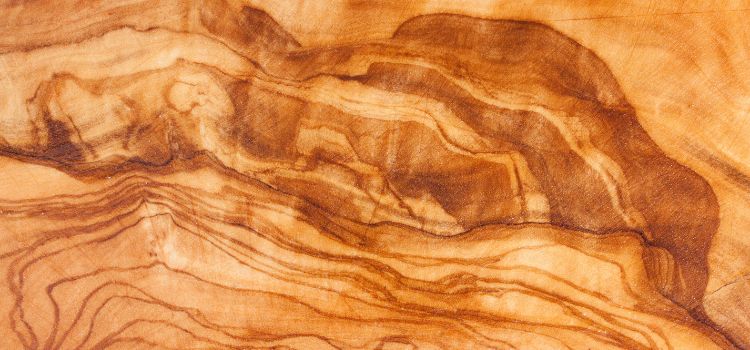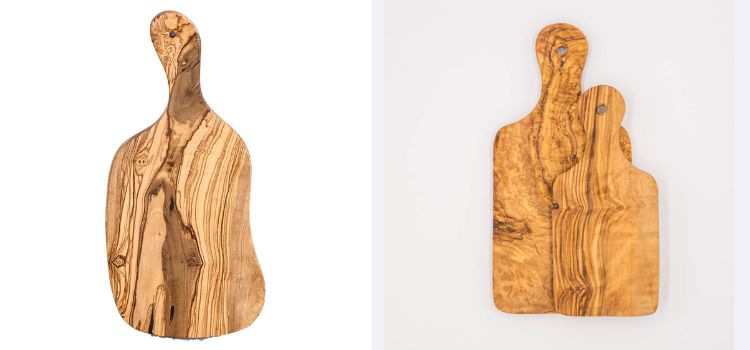As an Amazon Associate, I earn from qualifying purchases

Choosing the right cutting board is crucial for any kitchen, as it impacts not only the preparation of food but also the longevity of your knives and the aesthetic appeal of your culinary space. Cutting boards come in various materials, from plastic to bamboo to a wide range of hardwoods. Among these, olive wood has gained popularity for its unique characteristics and visual appeal.
This article seeks to explore whether olive wood is a suitable material for cutting boards by examining its properties, benefits, drawbacks, and how it compares with other common woods. Our goal is to provide you with the insights needed to make an informed decision that suits your kitchen needs and personal preferences.
Properties of Olive Wood
Olive wood is celebrated for its distinct appearance, characterized by rich, warm tones ranging from golden yellows to deep browns, often accentuated by intricate, swirling grain patterns that make each piece of wood truly one-of-a-kind. This visual appeal is complemented by a smooth texture that feels pleasing to the touch, making olive wood cutting boards not just functional tools but also beautiful kitchen accessories.
The wood itself is dense and hard, which contributes to its durability and resistance to wear and tear. Olive wood’s hardness ensures that it can withstand regular use without becoming easily damaged, although it remains gentle enough to prevent excessive dulling of your knife blades.
Additionally, olive wood is known for its aromatic qualities. The natural oils present in the wood give off a subtle, pleasant fragrance that can enhance the sensory experience of cooking. These oils also contribute to the wood’s natural antibacterial properties, helping to inhibit the growth of bacteria and maintain a hygienic cutting surface.
Benefits of Olive Wood for Cutting Boards
- Durability: Olive wood cutting boards are known for their strength. Their density and hardness make them highly resistant to scratches and gouges, ensuring a long-lasting surface that withstands daily kitchen activities.
- Aesthetic Appeal: Each olive wood cutting board is one-of-a-kind, featuring unique natural grain patterns. This not only enhances functionality but also adds beauty to any kitchen, often becoming conversation starters during gatherings or dinner parties.
- Natural Antibacterial Properties: Olive wood contains natural oils that provide antibacterial qualities. This is especially useful when handling raw meats or other ingredients that can harbor bacteria, offering extra peace of mind during food preparation.
Drawbacks of Olive Wood for Cutting Boards
- Cost: Olive wood cutting boards are generally more expensive than alternatives like maple or bamboo due to their limited availability and the craftsmanship involved in creating high-quality boards.
- Maintenance: While the natural oils in olive wood provide antibacterial benefits, they require regular replenishment. This means that olive wood boards need to be oiled more frequently than other types to prevent drying or cracking, adding to the upkeep for users.
- Susceptibility to Warping: Olive wood can warp if exposed to excessive moisture or drastic temperature changes. This demands careful handling and storage to keep the board in optimal condition, which may not be feasible for all kitchen environments or users.
Comparisons with Other Types of Wood

- Maple: A popular choice for cutting boards, maple is renowned for its hardness and durability. It is more affordable than olive wood and offers a neutral aesthetic that suits a variety of kitchen styles. However, it lacks the unique grain patterns and aroma of olive wood. Maple boards are also more resistant to warping and require less maintenance.
- Bamboo: Bamboo cutting boards are celebrated for their sustainability and eco-friendly appeal. They are harder than olive wood and offer good durability at a lower cost. However, bamboo can be tougher on knives and lacks the aesthetic uniqueness and antibacterial properties of olive wood. Bamboo boards also require less maintenance but can be prone to splitting if not properly cared for.
- Walnut: Walnut is often chosen for its rich, dark appearance and moderate hardness, which is gentle on knives. It is generally less expensive than olive wood but offers a similar level of aesthetic appeal. Walnut requires similar maintenance to olive wood but is less prone to warping, making it a versatile option for many kitchens.
Care and Maintenance Tips
Proper care and maintenance are essential to maximize the lifespan of an olive wood cutting board. Here are some tips to keep your board in excellent condition:
- Cleaning: After each use, wash the board with mild soap and warm water. Avoid soaking the board or allowing it to sit in water, as this can cause warping. Dry the board thoroughly with a towel immediately after washing.
- Oiling: Regular oiling is crucial to prevent drying and cracking. Use food-grade mineral oil or a specialized cutting board oil, applying it generously across the surface of the board. Allow the oil to soak in overnight, then wipe off any excess with a clean cloth. Aim to oil your olive wood board every few weeks or whenever it appears dry.
- Storage: Store your cutting board in a dry, well-ventilated area away from direct sunlight and heat sources. If possible, store the board upright to ensure even air circulation on all sides, which helps prevent warping.
Conclusion
Olive wood cutting boards offer a unique blend of durability, aesthetic appeal, and natural antibacterial properties that make them an attractive choice for many kitchens. While they may require more maintenance and come at a higher cost than some other options, their beauty and functionality can justify these considerations for those who appreciate the qualities olive wood brings.
Ultimately, the decision to choose an olive wood cutting board should be based on personal preferences, kitchen needs, and a willingness to invest in the care required to keep the board in pristine condition. Whether for daily use or as a statement piece, olive wood cutting boards can enhance both the functionality and style of your culinary space.
FAQ
Can you use olive wood for a cutting board?
Yes, olive wood is suitable for cutting boards. Its dense and hard nature makes it durable and resistant to scratches. Additionally, its natural antibacterial properties enhance hygiene. However, regular maintenance, such as oiling, is necessary to prevent drying and cracking, ensuring the board’s longevity.
Is olive wood safe for food?
Olive wood is safe for food use. It contains natural oils with antibacterial properties, which help inhibit bacterial growth. It’s important to ensure the wood is untreated with chemicals and properly maintained to preserve its safety and integrity, making it an excellent choice for food preparation.
What are the disadvantages of olive wood?
The disadvantages of olive wood include its higher cost compared to common alternatives like maple, due to limited availability. It requires regular oiling to maintain the wood’s integrity and prevent drying. Additionally, olive wood can warp if exposed to excessive moisture or temperature changes, necessitating careful storage.
Is olive wood high quality?
Yes, olive wood is considered high quality due to its density, durability, and unique aesthetic appeal with rich grain patterns. Its natural oils provide antibacterial properties, adding to its functionality. However, its premium quality often comes with a higher price and maintenance requirement compared to other woods.
As an Amazon Associate, I earn from qualifying purchases